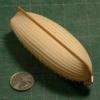-
Posts
13,300 -
Joined
-
Last visited
Content Type
Profiles
Forums
Gallery
Events
Everything posted by druxey
-
The scuttle (rather than hatchway) to the bread room was a lid in two layers. The top layer is the thickness of the deck plank, then a thinner lower layer running crossways and narrower all round, providing the lip. There are two ringbolts on opposite diagonal corners for lifting the lid.
-
Your skill is exemplary, Amalio!
-
I use an electric coffee-cup warmer for heating my Sparex.
- 1,449 replies
-
Silver soldering multiple joints is a challenge. Your solution of a one-shot deal was quite creative! Well done, Toni. I was taught to use different melting point solders for such situations. For the first joint or joints use 'hard' (highest melting point) solder, then 'medium' for the next and 'soft' (with the lowest M.P.) for the last joints. I believe that there is an even 'softer' grade now available. The other trick is to paint on yellow oxide (powder in water) over the joints you wish to protect; this inhibits the solder from re-melting. My jeweller friend showed me these techniques some years ago. Thank you, Shannon! You've saved my sanity on many occasions.
- 1,449 replies
-

Pandora by marsalv - FINISHED - 1:52
druxey replied to marsalv's topic in - Build logs for subjects built 1751 - 1800
Very nice work. The correct number of reef points on the sails are particularly impressive! -

Square or round tuck?
druxey replied to lmagna's topic in Building, Framing, Planking and plating a ships hull and deck
Without knowledge of the particular builders of Providence, it would be hard to determine which method was used in that specific case. My personal bet would be a square stern (not tuck), as this was more common on smaller vessels. Your observation on Chuck's Cheerful is a good one. This detail of construction is not usually seen on modern models. It was done this way with rabbets in both directions to prevent plank end-grain from being exposed to water. If not done, moisture followed by rot would quickly wick its way in. One can see this detail of construction on models in the USNA museum collection, as well as being explained in the new book on The Hayling Hoy of 1759-60. -
Also good references to consider: Darcy Lever, The Young Sea Officers' Sheet Anchor (A slightly later time period, though) David Antscherl, The Fully Framed Model, Volume IV C. Nepean Longridge The Anatomy of Nelson's Ships (Again, slightly later)
-
This looks like it's going to be another fascinating reconstruction! Interesting start, Dick.
- 263 replies
-
- nave tonda
- round ship
-
(and 2 more)
Tagged with:
-

Gondola by AntonyUK
druxey replied to AntonyUK's topic in - Build logs for subjects built 1901 - Present Day
An interesting challenge! Look forward to see how you will deal with this banana shaped hull. -

HMCSS Victoria 1855 by BANYAN - 1:72
druxey replied to BANYAN's topic in - Build logs for subjects built 1851 - 1900
Very nice metalwork, Pat!- 1,005 replies
-
- gun dispatch vessel
- victoria
-
(and 2 more)
Tagged with:
-
Beautiful workmanship as ever. However, I'm confused: isn't the garboard strake the outer plank or plate next to the keel? Or is this term applied differently in metal ships?
- 281 replies
-
- falls of clyde
- tanker
-
(and 2 more)
Tagged with:
-
Methodical or what? Very nicely done, Ed.
- 3,618 replies
-
- young america
- clipper
-
(and 1 more)
Tagged with:
About us
Modelshipworld - Advancing Ship Modeling through Research
SSL Secured
Your security is important for us so this Website is SSL-Secured
NRG Mailing Address
Nautical Research Guild
237 South Lincoln Street
Westmont IL, 60559-1917
Model Ship World ® and the MSW logo are Registered Trademarks, and belong to the Nautical Research Guild (United States Patent and Trademark Office: No. 6,929,264 & No. 6,929,274, registered Dec. 20, 2022)
Helpful Links
About the NRG
If you enjoy building ship models that are historically accurate as well as beautiful, then The Nautical Research Guild (NRG) is just right for you.
The Guild is a non-profit educational organization whose mission is to “Advance Ship Modeling Through Research”. We provide support to our members in their efforts to raise the quality of their model ships.
The Nautical Research Guild has published our world-renowned quarterly magazine, The Nautical Research Journal, since 1955. The pages of the Journal are full of articles by accomplished ship modelers who show you how they create those exquisite details on their models, and by maritime historians who show you the correct details to build. The Journal is available in both print and digital editions. Go to the NRG web site (www.thenrg.org) to download a complimentary digital copy of the Journal. The NRG also publishes plan sets, books and compilations of back issues of the Journal and the former Ships in Scale and Model Ship Builder magazines.



